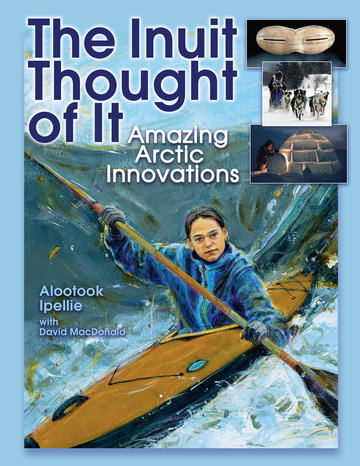Today’s Arctic communities have all the comforts of modern living. Yet the Inuit survived in this harsh landscape for hundreds of years with nothing but the land and their own ingenuity. Join authors Alootook Ipellie and David MacDonald as they explore the amazing innovations of traditional Inuit and how their ideas continue to echo around the world.
Some inventions are still familiar to us: the one-person watercraft known as a kayak still retains its Inuit name. Other innovations have been replaced by modern technology: slitted snow goggles protected Inuit eyes long before sunglasses arrived on the scene. Andother ideas were surprisingly inspired: using human-shaped stone stacks (Inunnguat) to trick and trap caribou.
Many more Inuit innovations are explored here, including:
• Dog sleds • Shelter • Clothing • Kids’ stuff • Food preservation • Medicine.
In all, more than 40 Inuit items and ideas are showcased through dramatic photos and captivating language. From how these objects were made, to their impact on contemporary culture, The Inuit Thought of It is a remarkable catalogue of Inuit invention.
- Age:
- 9 to 11
- Grade:
- 4 to 6
- Reading age:
- 9 to 11
- Joint winner, Skipping Stones Honor Book
- Joint winner, Top 10, Ontario Library Association
- Short-listed, Rocky Mountain Book Award
- Joint winner, Best Books for Kids & Teens, starred selection, Canadian Children’s Book Centre
- , Silver Birch Award
- Joint winner, The Year’s Best List, Resource Links
- Short-listed, Hackmatack Children’s Choice Book Award
“All of these innovations are well documented here, in text that is a pleasure to read.”
“[An] informative and easy-to-read book . . . attractive and useful.”
This slim but comprehensive look at Inuit technology and culture is an inspiring reference for Inuit children and will be illuminating for everyone else.”
“Chock-a-block full of interesting information and pictures.”
Buy this book at:
Annotations
The Inuit Thought Of It: Amazing Arctic Inventions
Explore the amazing inventions and innovations of traditional Inuit, and how their ideas continue to echo around the world.
An excellent example of a non-fiction text that provides fascinating and accessible information on Inuit culture and the Inuit’s ingenuity in inventing items essential for survival in the Arctic. Topics are presented with major title headings (e.g, Dog Sled) and subheadings (e.g., Rope, Sled, Mud runners, Ivory Runners). Text features include timelines, maps, photographs with captions, and an index.
Source: Association of Canadian Publishers. Top Grade Selection 2016.
The Inuit Thought of It: Amazing Arctic Innovations
Alootook Ipellie explains how the ability to adapt and make innovations enabled the Inuit to survive in the extreme conditions of the North American Arctic. All the innovations described predate contact with Europeans. Beginning with a timeline, Ipellie uses two-page spreads to show and write about everything from dog sleds to parkas, harpoons to snow goggles. Along the way, he comments on food, medicine, games, hunting and death customs, finishing up with a look at modern Inuit life. The book is well illustrated with colour and black and white photographs.
Source: The Association of Book Publishers of BC. Canadian Aboriginal Books for Schools. 2008-2009.
The Inuit Thought of It: Amazing Arctic Innovations
Annick Press has created this informative and easy to read book that will be a useful addition to any school library or classroom. Inuit author Alootook Ipellie, who recently passed away, had first-hand knowledge of the many and varied ways in which the Inuit survived their harsh environment and created tools and techniques that have been adopted around the world. Covering topics like transportation, food, clothing, shelter, hunting and medicine, the author tells of how the need to survive led to a spirit of innovation. Each chapter describes a traditional Inuit invention, such as the kayak, and tells how it was made, how it was used, why it was useful for the people and our modern-day adaptation of its basic principles. Life in an igloo is described in detail, and, while we don’t use igloos in the south, snow and ice buildings are popular at winter festivals. We do use the caribou skin sleeping bag in its modern form. When you read this book, you really understand how the people had to use anything they had to create the things they needed. In particular, they used the animals that they hunted, not only for their food but also for their clothing, some tools and summer shelter.
The book is full of photographs, both old and new, that provide a great extension to the text. The photo of the walrus intestine was something that was new to me! The text provides a good level of information without being too wordy. There is a section on the Inuit today and how their lives are different now. Overall, it is an attractive and useful book for anyone studying the Inuit and also for anyone who wants to find out about some of the remarkable inventions of a very resourceful people.
Source: The Canadian Children's Bookcentre. Winter 2008. Vol.31 No.1.
The Inuit Thought of It: Amazing Arctic Innovations
Explore more than 40 ideas crucial to Inuit survival. From items familiar to us today to inventive concepts that shaped their lives, celebrate the creativity of a remarkably resourceful people. Timeline, maps, further reading list, Inuit symbol chart and index included.
Source: The Canadian Children’s Book Centre. Best Books for Kids & Teens. 2008.






